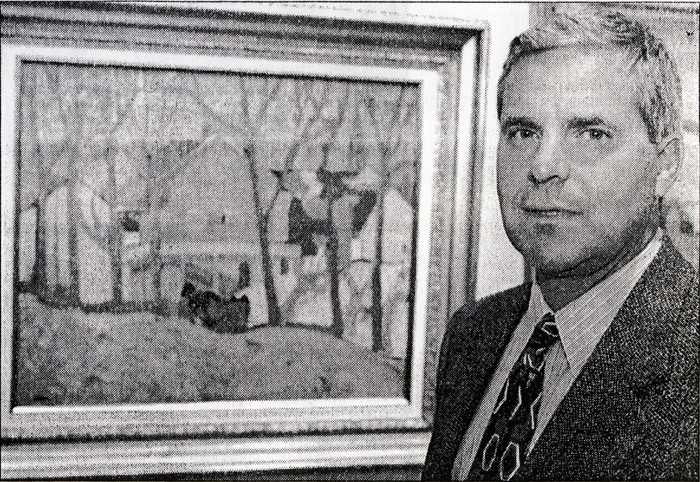Here's to you, Mr. Robinson

Klinkhoff Gallery pays well deserved tribute to undervalued master of Canadian painting
ANNE DUNCAN - Gazette Art Critic
THE GAZETTE, MONTREAL
Saturday, September 10, 1994
Albert H. Robinson (1881-1956) was the sort of artist who was invited to participate in the Group of Seven’s first collective exhibition in l920. He was even asked to join the Group, an offer that he turned down for philosophical reasons. He preferred to paint Quebec’s farms and villages rather than to trek out into the pre-Cambrian wilderness. Robinson was also the sort of artist who became a founding member of the Canadian Group of Painters – an outgrowth of the Group of Seven. He was one of the youngest associate members ever of the Royal Canadian Academy and he was given a retrospective at the National Gallery in 1955.
In his lifetime he earned effusive praise from fellow artists. Indeed, Robinson was known as a painter’s painter. A.Y. Jackson, who often worked and travelled with Robinson, said he learned a lot from his lesser-known companion, while Arthur Lismer once remarked about one Robinson painting: "Albert Robinson is a colorist of the first order. There is a wealth of graceful harmony in this simple picture that only comes into a work of art when the painter is sensitively aware of more subtle delicacies and qualities unknown – because (they are) unseen – to painters of less discernment."
Yet Robinson’s reputation, outside the tightly knit world of colleagues, curators and serious collectors, was so obscure that the Canadian Group of Painters he had helped found listed him in l954 as already being dead. Perhaps more insulting is the fact that Montreal, the Hamilton native’s adopted home for almost half a century, had never given him a major show until now.An exhibition of about 50 Robinson paintings opens today at Galerie Walter Klinkhoff.
The show is part of the gallery’s annual series of museum-quality historical exhibitions, rarities in the world of commercial art. None of the works in these Klinkhoff exhibitions is for sale. The Robinson paintings have been borrowed from the likes of the Montreal Museum of Fine Arts, the Musée du Québec, Power Corp., private collectors in Toronto, Ottawa, Calgary and other cities, and even out of the office of Premier Daniel Johnson. The Klinkhoff family willingly foots the bill for these exhibitions, which take up to a year to organize, considering them a public service to raise the profile of important artists who have been forgotten or who never received the recognition they deserved during their lifetimes. Robinson certainly seems to fit the criteria on both counts.
The Robinson exhibition is exceptional for several reasons. Even Walter Klinkhoff, who turned the organizing of the show over to his sons, Eric and Alan, was eagerly awaiting the exhibition’s start. "I thought – and still think – that in Canada we have a lot of artists who use a lot of grays," the elder Klinkhoff said this week. "But Robinson was really a most distinguished colorist…and his colors seem as fresh today as they must have when they first came off his palette." In fact, Klinkhoff is so taken with Robinson’s subtle and original use of color that the dealer has long considered this artist to be among his favorites – if not his favorite artist in Canada, better at times than Jackson. Yet for all his admiration for Robinson, Klinkhoff had never seen a major Robinson show until this one.
He missed a travelling retrospective in 1982-1983, a show that went to eight cities, across Canada but not in Montreal. "Even though Robinson painted almost exclusively in Quebec and lived here for almost 50 years, the exhibition never came here", son Eric said. So why is Robinson’s work not better known? Mainly, Eric and Alan Klinkhoff said, because Robinson suffered a severe heart attack in 1933 and the ensuing complications prevented him from painting again. But as artists, Robinson’s reputation was overshadowed by that of the self promoting Group of Seven.
Robinson was so self-effacing that he often gave away his work to neighbours or friends who did him special favors. And when Robinson sold his house on Vendome Ave., he simply left 30 or 35 paintings in the basement. Born into a non-artistic family, Robinson spent his school years doodling in the margins of his notebooks. When he left high school he got a job illustrating for the Hamilton Times newspaper at $5 a week, according to the slender exhibition catalogue, which quotes a Thomas Lee monograph about Robinson.
In 1903, Robinson went to Paris, first to study at the renowned Académie Julien and then at the Ecole des Beaux-Arts. It was probably in Paris that he developed his particular attitude toward color. As fellow artist Robert Pilot said at the opening of Robinson's l955 retrospective,: "His vision of color is most distinguished and subtle. Maurice Cullen remarked upon the difficulty of painting in low tone but high in key. We see in these canvases how well Mr. Robinson has solved this problem. Here the colors are muted, but how joyously they sing." And it is precisely that joy that comes through the Klinkhoff show. It should have been presented in Montreal decades ago. Robinson might not have been the greatest or most innovative Canadian artist, but the Klinkhoff exhibition shows he doesn’t deserve to fall through the cracks as he almost has.
The Albert Robinson exhibition opens today at the Galerie Walter Klinkhoff, 1200 Sherbrooke Street. W. and continues until Sept. 24.
Copyright © The Gazette, Montreal








